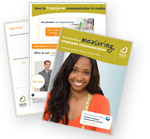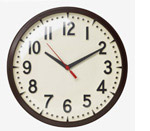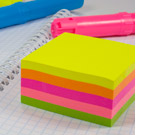
Your town hall meetings probably follow a common format: a 45-minute Microsoft PowerPoint presentation followed by 15 minutes of Q&A. But you've probably wondered how you could make the Q&A segment more engaging—to encourage employees to ask more questions and create a livelier exchange between leaders and participants.
Did you know that making the presentation much shorter, or even eliminating it altogether, can dramatically improve interaction? It may sound radical, but it's true: There's an inverse ratio between presentation time and level of participation. So, if you limit (or ditch) PowerPoint, you will create more energy and engagement. Here are four ways to do so:
 |
Put a handout in everyone's hands Who says PPT is the only presentation tool? Sometimes, a handout—a one-pager or even a booklet with four to eight pages—is even more effective, especially if you want participants to play a role. Create your handout to include key points, space for notes and exercises that allow for participation. Having information in their hands will help employees follow along and absorb key concepts. |
 |
Play a movie If you want to tell a story, bring it to life with a video. Break up your presentation with one or more clips that employees can relate to. For example, to show how the manufacturing plant improved its safety ratings, play a short video of safety training. Once the video is over, use it as an opportunity to stimulate dialogue by segueing into Q&A or holding a breakout session. |
 |
Create more time for Q&A The clock is your friend. By reversing town hall timing—for example, limiting the presentation to 20 minutes, and expanding Q&A to 40—you'll give the Q&A new life. Afraid employees won't ask questions? Then don't put them on the spot. Instead, have a senior leader begin the dialogue by asking a question, like this: "What are the obstacles to achieving our objectives?" Let employees respond by sharing what they know and they'll be more likely to raise their hands. |
 |
Break out Even confident employees find it hard to speak in front of a large group. So make it easier for employees to participate by breaking them out into smaller groups. Arrange the room in tables of six or eight and provide supplies like flip chart paper, markers, scissors and tape. After a brief presentation, give each group an issue to address or a problem to solve. Have each group sketch their ideas, and then display the final products on flip charts for all to see and discuss. This activity allows employees to collaborate, get creative and feel involved. |



